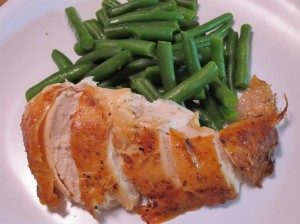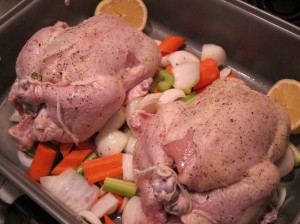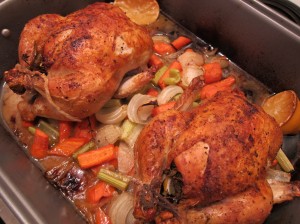
Juicy Roast Chicken and Green Beans
I know I said I’d cook more using recipes from my vast collection of cookbooks, but it was just one of those days. At work, tired, wanting something healthy and delicious to eat for dinner, but not wanting to cook. I knew I needed something to blog about, but whatever; the blog post could wait. I was thinking perhaps I’d pick up a rotisserie chicken from the local rotisserie chicken place or from Whole Foods and be done with it. No pans to clean, no carving, no hassle. That’s when I ran across a blog post by Michael Ruhlman, “America: Too Stupid To Cook,” and hung my head in shame.
The point of Mr. Ruhlman’s article is a bit different than this post, which is meant to give weeknight cooking a bit of perspective, but worth noting. Briefly, Mr. Ruhlman’s point is that Americans are made by the media to feel as if they aren’t talented enough to put a meal on the table unless it comes from a microwaveable box, or if they are specifically told a recipe is easy. I can’t agree with him more. Even shortcuts from shows like The Food Network’s 30 Minute Meals may overwhelm many. We never seem to have all the ingredients, and frankly it seems like so much work. To some, watching Rachael Ray, the show’s host, make one meal in her perfectly-organized kitchen with plenty of counter space is akin to watching a short-order cook assemble 20 breakfasts simultaneously. It’s daunting, and makes people uncomfortable in their own kitchens. (Note that I disagree with Ruhlman’s putdown of 30 Minute Meals. Watching Ms. Ray cook, or for that matter exist on this planet, may be akin to enduring nails on a blackboard (my thoughts, not his), but for the most part the show provides relatively-healthy, well-rounded recipes, that do involve “real cooking.” More power to her producers if the show actually does motivate some people to get past their fears and into their kitchens to cook.) Mr. Ruhlman goes on to state, “…the notion that cooking is hard and that it takes a long time and we’re just too stupid to cook is wrong.”
Which brings me to my point. Left to their own devices with only an oven and a piece of meat, I’m pretty sure anyone can figure out that they need to turn the oven on and put the meat inside the oven to cook it. But because people are hammered by TV, websites, magazines, and cookbooks with a million techniques, they become frightened and don’t cook at all. A million questions are then asked: What temperature do I cook the meat? It doesn’t matter much – either a low temperature for a long time or a higher temperature for a shorter time. Do I need to marinate? Nice, but not necessary. What about seasonings? Salt and pepper do just fine. When is it done? When it is cooked. Really, stop worrying! Block out the noise in your head. Do what feels right. Our grandparents did not have the luxury of meat thermometers, or ovens that told (or even held) an actual temperature, or a bookstore filled with hundreds of cookbooks, or exotic ingredients just a click away. They simply put real food on the table. That’s what we should aspire to.
To continue with the story of the chicken, my personal shame after reading Mr. Ruhlman’s article came not from a feeling that I couldn’t cook. My shame came from knowing that I can cook a perfectly delicious, healthy meal, without much trouble, and that I was choosing not to because I was tiiirrreeed. I’ve been choosing to do this for most of my adult life, and I should have learned by now that this is a terrible waste on so many levels. Don’t get me wrong, if you’re going to go the fast-food route, a rotisserie chicken is possibly one of the best options. But for me, someone with easy access to good ingredients, who knows how ridiculously simple it can be to roast a chicken, it seemed silly. I was about to spend too much money for too little food, with questionable nutritional value, for poultry that was probably raised in a factory. I decided I would get over myself and roast a chicken.
But, wait. Why just one chicken? Roasting one chicken is just as easy as roasting two, and if I roasted two I could make chicken salad the next day. And then if I had two roasted chicken carcasses, I could make quite a bit of chicken stock, which could go into soups and sauces. All of this would come from maybe 45 minutes of hands-on work all told. Here’s how it went:
Roast Chicken:
- On my way home from work, I purchased two small chickens, about 2.75 lbs. each. (I find smaller chickens remain far more moist than their bigger siblings, and they feed my family of three perfectly.)
- As soon as I arrived home, before I even changed my clothes, I turned the oven to 475 degrees F.
- While the oven was heating, I cut two peeled medium onions, a couple of unpeeled carrots, and two stalks of celery into large chunks, threw them into a roasting pan, drizzled some olive oil, salt, and pepper on them, and tossed the vegetables with my hands. This would serve as the rack for the chicken, and provide some additional flavor. If I had potatoes, those would have gone in too, and I would have served roast potatoes with my chicken. But I had no potatoes, oh well. Next time! (Have no vegetables? No worries, leave them out.)
- I patted the chicken dry with paper towels. I cut two lemons in half and shoved one half of a lemon into each of the chickens. The other halves I squeezed over the chicken and vegetables and tossed into the pan. (I love lemon with poultry, and I nearly always have lemons in the house. If you don’t have lemons, don’t worry about it – skip ’em!)
- I shoved a half handful of rosemary and thyme in the cavity with the lemons. (I have rosemary and thyme plants in my home. You could also use a couple of tablespoons of dried herbs. Any combination of herbs is good here – oregano, sage, etc. Or you could skip the herbs altogether should you not have any at hand or are feeling particularly lazy.)
- I drizzled olive oil on the chickens, then some salt and pepper, gave them a good rub down, and tied their little legs together. (I only truss a chicken to keep the leg meat from shrinking off the bones, and it keeps the birds shape nicer. If you have no twine, or have little inclination, it is not necessary.)
- I put the roasting pan with the vegetables and the chickens into the oven and immediately turned the temperature down to 400 F.
- For the next hour and ten minutes, I changed into more comfortable clothes and fiddled about on my computer a while. I figured I should check the birds for doneness just about an hour after I had put them in the oven. No need – I actually smelled a distinct difference in the aroma of the house. I ran downstairs, tested the thigh meat with a meat thermometer and pulled the birds out to let them rest. (No thermometer? Pull the leg away from the body just a bit and see if the juices run clear. No pink juice means they’re done!)
- While the chickens were lying about, I put a bag of frozen green beans in the microwave to steam per the directions, dumped them in a bowl with a bit of butter and salt.
- I then carved the chicken, and we ate. (“Carved” sounds more elegant than it was, which was more like tearing it apart with my hands. Chickens this small stay pliant and nearly fall into pieces.)

Roast Chickens Ready for Roasting

Roasted Chickens
Ultimately, the only thing you *need* here is an oven, a chicken, a roasting pan, and some salt and pepper. I know some people would not use salt at all, but that’s completely against my culinary principles.
If you want to make things complicated, possibly the best roast chicken I’ve ever made was the one from the Zuni Cafe Cookbook. You can see an adapted recipe here. This will require salting the chicken a day ahead, preheating a pan, searing the breast, etc. It is not difficult, and it’s definitely worth cooking, but it’s not necessarily something I’d want to tackle during the week.
The next evening I made chicken salad from the second chicken. This cranberry walnut version is a delicious recipe that takes only a few minutes to make. Chicken salad is super easy – it’s just diced chicken tossed with a perked-up mayonnaise dressing.
Two days later I made chicken stock. I pulled the skin/fat off the backs of the carcasses, cut some carrot, celery, and shallot (I didn’t have onions) into pieces, bundled some thyme and a bay leaf, put it all in a pot and covered it all with cold water. I left it on a high simmer for three hours. Because we did such a good job eating the chicken, there was very little protein or fat to skim off. I would up with four quarts of beautiful chicken stock!
Two chickens, several meals, and a valuable lesson learned. It truly didn’t take much effort to feed me and my family a few wholesome meals, and it cost significantly less money than take-out. So while I’ll continue with the cookbook experiment, you’ll definitely be seeing these toss-it-together weeknight recipes as often.